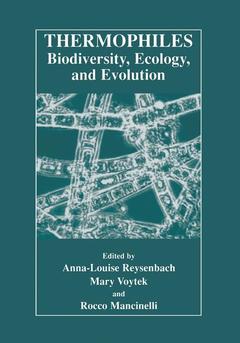Thermophiles: Biodiversity, Ecology, and Evolution, Softcover reprint of the original 1st ed. 2001 Biodiversity, Ecology, and Evolution
Langue : Anglais
Coordonnateurs : Reysenbach Anna-Louise, Voytek Mary, Mancinelli Rocco

These are indeed exciting times to be a microbiologist. With one of the buzzwords of the past decade-"Biodiversity," and microbes are reveling in the attention as they represent by far most of the biodiversity on Earth. Microbes can thrive in almost any environment where there is an exploitable energy source, and, as a result, the possible existence of microbial life elsewhere in the solar system has stimulated the imaginations of many. Extremophiles have taken center stage in these investigations, and thermophiles have taken on the lead roles. Consequently, in the past decade there has been a surge of interest and research in the Ecology, Biology, and Biotechnology of microorganisms from thermal environments. Many of the foundations of thermophile research were laid in Yellowstone National Park, primarily by the research of Professor Thomas Brock's laboratory in the late 1960s and early 1970s. The upper temperature for life was debated, the first thermophilic archeum discovered (although it was only later shown to be an archeum by ribosomal cataloging), and the extremes of light, temperature, pH on the physiology of microorga nisms were explored. Interest in thermophiles increased steadily in the 1970s, and with the discovery of deep-sea hydrothermal vents in 1977, thermophilic research began its expo nential explosion. The development of Taq polymerase in the polymerase chain reaction (peR) focused interest on the biotechnological potential of thermophilic microorganisms and on the thermal features in Yellowstone National Park.
The Origins of Research on Thermophiles; Th.D. Brock. Thermophilic Microorganisms in the Deep Sea; D. Prieur, et al. Biodiversity of Acidophilic Moderate Thermophiles Isolated from Two Sites in Yellowstone National Park, and Their Roles in the Dissimilatory Oxido-reduction of Iron; D.B. Johnson, et al. Presence of Thermophilic Naegleria Isolates in the Yellowstone and Grand teton National Parks; R.F. Ramaley, et al. Examining Bacterial Population Diversity Within the Octopus Spring Microbial Mat Community; M.J. Ferris, et al. Direct 5S rRNA Assay for Microbial Community Characterization; D.L. Stoner, et al. Community Structure Along a Thermal Gradient in a Stream near Obsidrian Pool, Yellowstone National Park; J.R. Graber, et al. Isolation of Hyperthermophilic Archaea Predicted by in situ RNA Analysis; S. Burggraf, et al. Thermophilic Anoxygenic Phototrophs: Diversity and Ecology; M.T. Madigan. Microbial physiology at high temperature, low pH, low pCO2: Implications for evolution and ecology; L.J. Rothschild. The Zonation and Structuring of Siliceous Sinter Around Hot Springs, Yellowstone National Park, and the Role of Thermophilic Bacteria in its Depostion; D.R. Lowe, et al. Use of 16S rRNA, lipid and naturally preserved components of hot spring mats and microorganisms to help interpret the record of microbial evolution; D.M. ward, et al. Research Accomplishments of a small Business Utilizing Yellowstone's Extremophiles; J. Combie, K. Runnion. The Yellowstone Microbiology Program: Status and Prospects; J.D. Varley, et al.
Date de parution : 09-2012
Ouvrage de 205 p.
17.8x25.4 cm
Disponible chez l'éditeur (délai d'approvisionnement : 15 jours).
Prix indicatif 105,49 €
Ajouter au panierDate de parution : 02-2001
Ouvrage de 206 p.
Thèmes de Thermophiles: Biodiversity, Ecology, and Evolution :
Mots-clés :
Bur; Evolution; biodiversity; biotechnology; ecology; microbiology; physiology
© 2024 LAVOISIER S.A.S.



